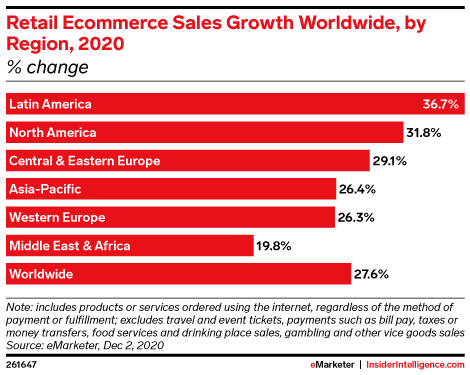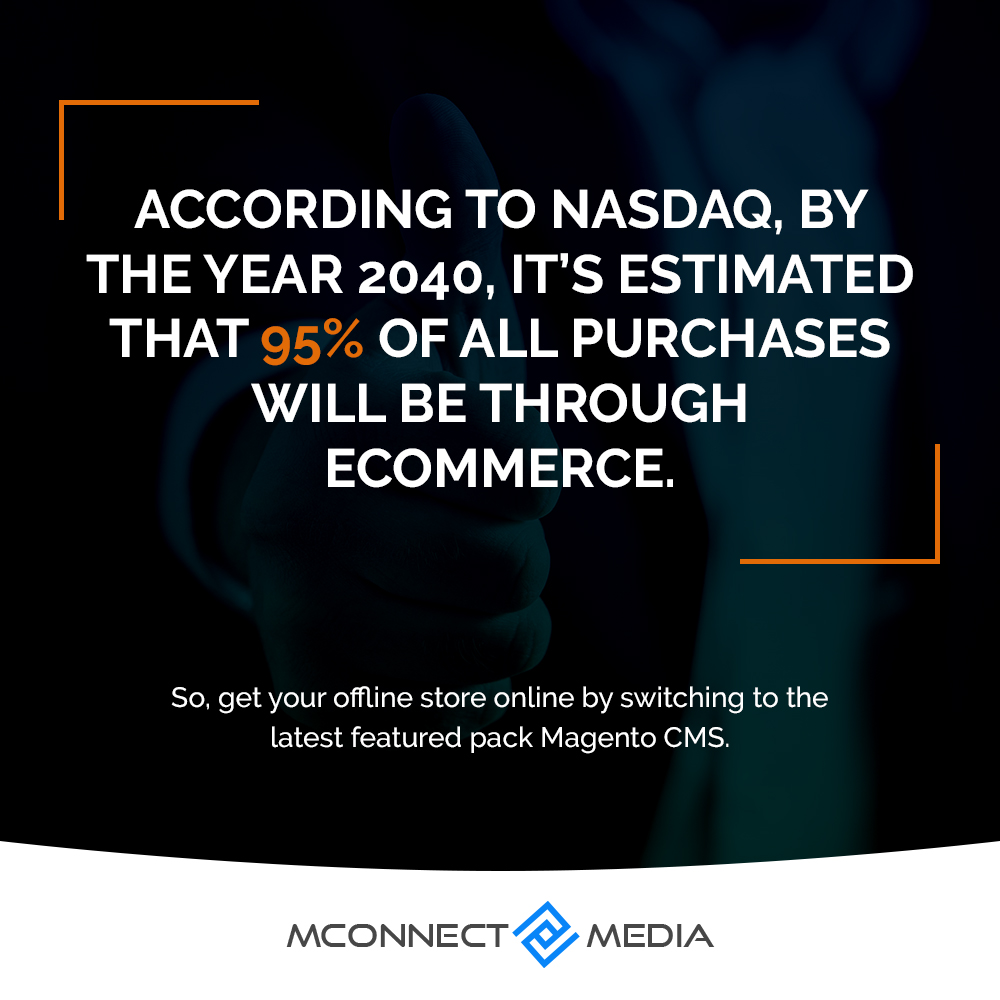Table of contents:
- The rise of voice commerce
- Omnichannel shopping becoming the new normal
- Enhancing the Ecommerce Experience with AI and AR
- The emergence of new payment options
- Mobile commerce dominating
- Growth in visual commerce
- Online buying will not be limited to B2C products
- Increase in the popularity of self-service platforms
- Shoppable video ads on social media
- Influencers will become brand partners
- Personalization will go beyond making a purchase to making a bond
- Impact of sustainability practices on sales
Ecommerce has become a lifeline for many businesses during the pandemic. The pandemic has had an immediate effect on buyer behavior that has accelerated the digital transformation for many companies that have adopted new technologies to enable ecommerce for their organization from retailers, restaurants, educational institutions, manufacturers, distributors, e-government, pharma/biotech, healthcare, hotels, and consumer goods.

Driven by pandemic customer demand, ecommerce sales grew by over 30% during 2020.
Many customers were forced to shop online because retailers were forced to shut down their physical locations due to the pandemic.
The pandemic has increased $107 billion in ecommerce sales worldwide.

- By the year 2040, it’s estimated that 95% of all purchases will be through ecommerce (Nasdaq)
- 93.5% of global internet users have purchased products online (OptinMonster)
- Online stores with a social media presence have an average of 32% more sales than those that don’t (BigCommerce)
The following are the ecommerce trends for 2021 that will help you to develop your future strategy.
To shop products online, people are increasingly relying on voice assistants like the Amazon Echo with Alexa, Siri from Apple and the Google Home Assistant to search anything. By 2025, 75% of U.S. households will have smart speakers. Voice commerce sales are expected to surpass $40 billion by the year 2022.
The increasing accuracy and convenience of technology are other reasons why voice commerce is on the rise. To help consumers shop more conveniently, both Google and Amazon are pushing regional languages in their virtual assistant devices.
Omnichannel retailing refers to delivering buyers a seamless and consistent experience across channels and devices. The number of Omnichannel customers will increase even more in 2021 with the increase in the adoption of mobile devices and voice assistants.
Here are a few ways to offer a seamless omnichannel experience;
- If you have the budget, then create a mobile app or a PWA and optimize your website for mobile devices.
- At every step, personalize the customer experience.
- To ensure a personalized and comprehensive ecommerce experience with end-to-end online retail processes, use tools like SAP Commerce Cloud.

You will likely see an improvement in conversions and a decrease in the return rate by implementing AI and AR in your ecommerce store.
By offering personalized guidance and recommendations to your customers, Artificial intelligence (AI) acts as your online in-store associate. Artificial Intelligence uses customer’s past purchase history and browsing behavior to show them products they are more likely to buy.
Online shoppers can’t try on the product that they intend to buy unlike in physical stores. Augmented reality (AR) helps eradicate this hurdle by allowing customers to see how a specific product would look on them even before they purchase the product.
Payment options are one of the main reasons customers choose a specific brand. If you do not offer your customers a few payment methods, they will not purchase from your ecommerce store.
So far, most ecommerce businesses accept digital wallets such as Google Pay, Samsung or Apple Pay, and PayPal in addition to debit and credit cards. There are many benefits for online shop owners, such as low transaction fees and no reverse transactions, such as cryptocurrencies, especially Bitcoins.
Because consumers rely on the increase in online shopping, they find it easier to shop using their mobile devices. As an online seller, you should focus on improving the customer experience for mobile users.
Here are some great ways to prepare your ecommerce site for mobile devices:
- Implement Fast Mobile Pages (AMP) for buyers who visit your site using smartphones.
- Make sure you check out on mobile devices and find ways to make it easier.
- Manually check your mobile site. Check if the product is easy to view on your mobile and if there is an option to zoom.
Visual Commerce refers to engaging and converting customers not only on product pages but also across your store. Large retailers use visual commerce to influence buyers. They have high-quality images with shortcuts on their homepage to buy the product directly.
Here are some great ways to take advantage of the visual business:
- Take 360-degree photos or videos of your best-selling product.
- Invest in a visual search tool to allow users to search for products using images.
- To create interest, recreate user-generated content on your product pages.
- Create visual shopping ads on Pinterest to drive traffic and increase sales to your website.
Businesses increased their digital transformation strategies despite global shifts in 2020, and disruption wasn’t just a buzzword. Consumers who had no other choice turned to ecommerce for everything they wanted in their everyday lives.
B2B has also adopted ecommerce channels for all types of purchases for their companies from small businesses to large corporations. Examples include Amazon, Walmart, Alibaba, eWorldTrade, AutoGlobalTrade, McKesson, Fire Rock, Wayfair, ThomasNet, Ferguson etc.
People could no longer just order food, fashion, and gadgets online and have them shipped to their homes. Groceries, furniture, and even automobiles are all available.
Getting started on the internet used to be a tedious and time-consuming process. However, the year 2020 has shifted the paradigm and shown how small companies and remote workers can easily digitally turn their businesses.
Chris Byrne, CEO of Sensorpro said that the trends for 2021 will be in favor of platforms that launch and sell rapidly online, without the need for a small army of developers and consultants.
Global ecommerce trends for digital marketing agencies in San Diego need to be among the top priorities for most business owners in 2021.
In 2021, social media use will continue to grow, and brands will begin to advertise in new ways on platforms like TikTok and Instagram.
As per Digital Growth Initiator Eduard Klein, zoomers swipe through TikTok and Instagram feeds for hours at a time. Merchants are ecstatic; video is the ideal medium for reaching out to the interested young target audience. They make purchasing decisions based on their social media feeds, and videos enable them to shop right away.
Influencer marketing can be highly beneficial for an ecommerce brand. Many brands have reached out to influencers to leverage their vast audiences. It was predicted that the influencer marketing industry will go up to $9.7B in 2020.
Creating enough content to support their marketing efforts has become a challenge for many ecommerce brands, which is why brands are using influencers as content creators to support the process of content creation.
Customers prefer to have experiences that are personalized to meet their individual requirements. Personalization can help you develop a long-lasting customer relationship. You can record your customer’s information, with their consent, to remember what and when they buy and offer suggestions for further steps.
Brands can also create a personalized customer service experience by using the information that is stored in a CRM database notwithstanding which channel is used by a customer to interact.
Online sales have a positive impact by being environmentally friendly. There should be active participation of ecommerce in the green consumerism wave as consumers are also considering environmental issues to be a part of their purchasing process. Consumers, especially millennials seek to work with businesses that provide environmentally-friendly products.
The focus of customers on environmental sustainability clearly indicates that environmentally-friendly practices must be adopted by online sellers. This can be done by sourcing products only from fair-trade associations or using recycled material for packing. A greener online selling environment and more positive consumer interaction will be established by such steps.
Businesses can use trends, insights, and internet marketing in San Diego to drive continued innovation. Potential innovation opportunities can be found by reviewing broad and detailed industry data. A culture of innovation can be created in your organization by continuous experimentation, analysis, and improvement.
Deepak Wadhwani has over 20 years experience in software/wireless technologies. He has worked with Fortune 500 companies including Intuit, ESRI, Qualcomm, Sprint, Verizon, Vodafone, Nortel, Microsoft and Oracle in over 60 countries. Deepak has worked on Internet marketing projects in San Diego, Los Angeles, Orange Country, Denver, Nashville, Kansas City, New York, San Francisco and Huntsville. Deepak has been a founder of technology Startups for one of the first Cityguides, yellow pages online and web based enterprise solutions. He is an internet marketing and technology expert & co-founder for a San Diego Internet marketing company.



